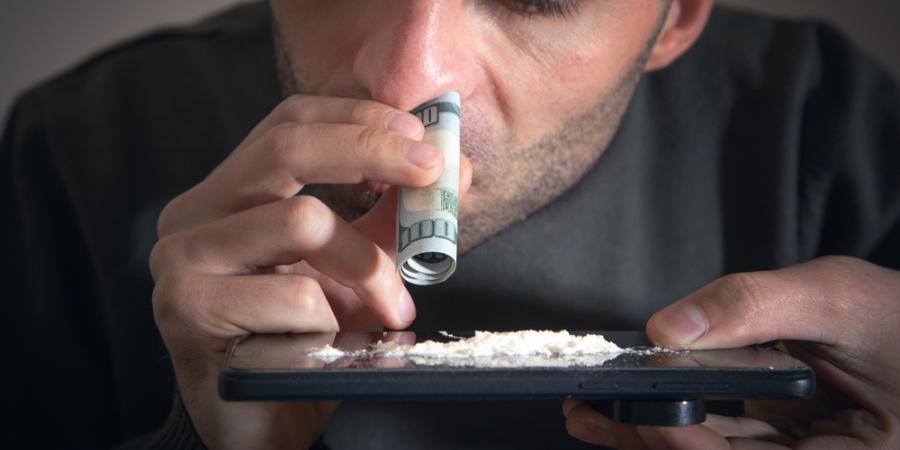Last Updated:
September 18th, 2025
The Office for National Statistics data shows us that 1,118 people died from cocaine-related causes in 2023 (a 12th consecutive annual rise). While many of those deaths were from overdoses, a large percentage were not due to cocaine specifically, but to the addition of dangerous additives.
We dive deeper into the ingredients and properties of cocaine, including the diverse cutting agents used and the growing dangers for people with cocaine addiction.
What is cocaine made from?
Cocaine is a highly addictive stimulant drug made from the leaves of the coca plant (Erythroxylum coca), primarily found in South America. Once harvested, the coca leaves are put into a chemical extraction process. This transforms the alkaloids in the leaves into a white, crystalline powder known as cocaine hydrochloride. This is the purified form of the drug that is typically snorted or dissolved for injection.
Cocaine hydrochloride is a known central nervous system stimulant. It creates a rush of dopamine in the brain with effects such as euphoria, energy surges and increased alertness. The immediate potential negative effects can be a rapid heart rate, anxiety, paranoia and aggression.
While cocaine in its purest form poses serious risks, it is rarely sold and consumed in that state in most parts of the world. Most cocaine in street-sale circulation is mixed with other substances, known as adulterants or ‘cutting agents’, which can carry life-threatening risks.
Is all cocaine the same?
Cocaine is used in many forms. When we think of a depiction of cocaine, its “powdered” form is usually the first that comes to mind. Powdered cocaine is the most commonly consumed and is a fine, white, odourless substance, usually snorted or rubbed into gums.
Yet there are other names for different forms of cocaine, each with different levels of risk due to their potency. Some of these forms include:
- Crack cocaine: The second most commonly abused form of cocaine, crack is formed by cooking powdered cocaine with baking soda, then breaking it down into small, yellowish “rocks.”
- “Fishscale” cocaine: Fishscale has notably high cocaine purity. It’s a slang name relating to the substance’s shiny and flaky appearance.
- Pink cocaine: This is often brightly coloured and grew in popularity around 2019 as a luxury party drug. Despite its name, it rarely contains cocaine, instead being a mix of MDMA, ketamine, or other substances.
- Black cocaine: In some regions of the world where cocaine is mass-produced, “black cocaine” is in circulation. This dark, chemically altered form tries to get around detection by border authorities, including sniffer dogs.
- Coca-paste: Another popular form of cocaine in South American countries, coca-paste is an intermediary product in the chemical extraction from coca leaves. It is smoked in its dried form, which can contain from 40% to 91% pure cocaine.
Regardless of the type or appearance, all cocaine is highly addictive and can be especially dangerous when mixed with additives.
Which cutting agents are commonly found in cocaine?
Very rarely is cocaine purchased at street-level pure. Illicit cocaine dealers regularly cut cocaine with a wide range of products to bulk out the product. Some cutting agents will mimic the appearance and texture of cocaine, while others will be added to enhance cocaine’s effects.
Here’s a breakdown of the most commonly used adulterants in cocaine sales:
Pharmaceutical additives
Lidocaine is a numbing agent typically used in dentistry. Research suggests that it is one of the most frequently used local anaesthetics in the adulteration of illicit cocaine. The effects of lidocaine mimic cocaine’s numbing effects, which may trick a person into thinking the product is purer than it really is.
Similarly, benzocaine is often used as a cutting agent in cocaine street sales. The UK Serious Crime Act 2015 highlights how frequently benzocaine is added, namely for bulking cocaine out and increasing its street value.
Caffeine is another frequently added adulterant. Science News reported that in South America, distributors started cutting their products with caffeine in the mid-2010s. In combination with cocaine, caffeine has a dangerous propensity to heighten cardiovascular strain.
Inert fillers and household substances
Talcum powder, cornstarch and baking soda are all household stock items frequently used in cocaine cutting. They are generally all used to bulk up the quantity of cocaine for street sale. While not dangerous in small amounts, these products can irritate the nasal passages and lungs when ingested with powdered cocaine. They also carry the risk of infecting the lungs when snorted over prolonged periods.
Fentanyl and other highly toxic agents
Fentanyl, used as a cutting agent in cocaine, has been a growing concern in the opioid epidemic of the past few years. One research paper from 2023 in the United States looked at over 700 samples from 77 harm reduction programmes and clinics in 25 US states. It found a prevalence rate of almost 15% in the samples of powder cocaine. Fentanyl is reported as being 50 times stronger than morphine and massively increases the risk of fatal overdose, even in trace amounts of powdered cocaine.
Levamisole is also commonly mixed into street-sale cocaine. Originally used to treat parasitic infections in animals, levamisole has been linked to serious immune suppression and even skin necrosis in humans. Alarmingly, the last decade has seen a stark increase in levamisole used as a cutting agent in cocaine sales across the world.
How these additives affect the body
Cocaine has multiple adverse effects on the body by itself, but when adulterants are added, the dangers of cocaine abuse amplify. Because users often have no idea what’s really in the drug, nor any way to check, each use comes with the potential for greater harm.
Some of the short-term effects include:
- Increased risk of overdose: Cocaine alone already presents a serious risk of overdose, but when mixed with fentanyl or other synthetic stimulants, the body is quickly pushed beyond its threshold.
- Greater strain on the heart and brain: Cocaine raises oxygen demand in the body by increasing both heart rate and blood pressure. If it’s mixed with other substances that increase these factors, there can be a greater risk of heart attacks, strokes, or potential sudden death.
More long-term health risks of cocaine use could include:
- Respiratory damage: If fillers and cutting agents like talcum powder or cornstarch are inhaled, there can be varying degrees of lung damage, including inflammation and the risk of infection.
- Immune system deficiencies: Chronic cocaine use has already been shown to impair a person’s immune system, with some studies drawing a link to an increased likelihood of developing AIDS. If a person takes cocaine cut with substances like opioids, there may be further compromises to the immune system and more frequent sickness.
- Mental health deterioration: For people with a cocaine addiction, it is tragically common to experience severe mental health and psychiatric disorders. When cocaine is mixed with cutting agents, mental health effects become even more unpredictable.
Where can I get help for cocaine addiction?
The truth is, you never really know what’s in the cocaine you’re using. The countless variables and outcomes of taking cocaine mixed with a cutting agent can have life-threatening consequences. If you or a loved one are struggling with intense cravings and battling addiction, please know that we’re here for you.
At UKAT, we offer expert-led treatment programmes for cocaine addiction, designed around your needs. Our team provides safe, medical detox support to manage withdrawal, followed by proven therapies to address the underlying causes of addiction.
Don’t wait for things to get worse. Whether you’re worried about your own use or concerned for a loved one, our team is here to help you make sense of what you’re going through.
Take the first step today. Contact us to take the first step on the recovery journey, free from addiction.
(Click here to see works cited)
- “Deaths Related to Drug Poisoning in England and Wales: 2023 Registrations.” Deaths Related to Drug Poisoning in England and Wales – Office for National Statistics, Office for National Statistics, 22 Oct. 2024, www.ons.gov.uk/peoplepopulationandcommunity/birthsdeathsandmarriages/deaths/bulletins/deathsrelatedtodrugpoisoninginenglandandwales/2023registrations.
- National Center for Biotechnology Information. PubChem Compound Summary for CID 656832, Cocaine Hydrochloride. https://pubchem.ncbi.nlm.nih.gov/compound/Cocaine-muriate
- Kudlacek O, Hofmaier T, Luf A, Mayer FP, Stockner T, Nagy C, Holy M, Freissmuth M, Schmid R, Sitte HH. Cocaine adulteration. J Chem Neuroanat. 2017 Oct;83-84:75-81. doi: 10.1016/j.jchemneu.2017.06.001. Epub 2017 Jun 12. PMID: 28619473; PMCID: PMC7610562.
- “News: October 2019 – UNODC-Smart: ‘pink Cocaine’ and Online Drug Sales Discussed in New Global Smart Newsletter.” UNODC, www.unodc.org/LSS/Announcement/Details/4b6b2964-6ead-44e8-86f1-b60ac3b77eef
- Jeri FR. Coca-paste smoking in some Latin American countries: a severe and unabated form of addiction. Bull Narc. 1984 Apr-Jun;36(2):15-31. PMID: 6569819.
- Cunningham, E.E, et al. “Cocaine and Lidocaine in Combination Are Synergistic Convulsants.” Brain Research, Elsevier, 9 Dec. 1997, www.sciencedirect.com/science/article/abs/pii/S0006899396010049.
- Office, Home. “Explanatory Notes to Serious Crime Act 2015.” Explanatory Notes, King’s Printer of Acts of Parliament, www.legislation.gov.uk/ukpga/2015/9/notes/division/3/4
- Brookshire, Bethany. “Caffeine Gives Cocaine an Addictive Boost.” Science News, 9 Aug. 2019, www.sciencenews.org/blog/scicurious/caffeine-gives-cocaine-addictive-boost.
- “Prevalence of Fentanyl in Methamphetamine and Cocaine Samples Collected by Community-Based Drug Checking Services.” Drug and Alcohol Dependence, Elsevier, 5 Oct. 2023, www.sciencedirect.com/science/article/pii/S0376871623012231.
- The Facts about Fentanyl, www.cdc.gov/overdose-resources/pdf/CDC_Fentanyl-Fact-Sheet_General_508.pdf
- Lawrence LA, Jiron JL, Lin HS, Folbe AJ. Levamisole-adulterated cocaine induced skin necrosis of nose, ears, and extremities: Case report. Allergy Rhinol (Providence). 2014 Jan;5(3):132-6. doi: 10.2500/ar.2014.5.0101. PMID: 25565048; PMCID: PMC4275458.
- Solomon N, Hayes J. Levamisole: A High Performance Cutting Agent. Acad Forensic Pathol. 2017 Sep;7(3):469-476. doi: 10.23907/2017.039. Epub 2017 Sep 1. PMID: 31239995; PMCID: PMC6474566.
- Gayle C Baldwin a, et al. “Acute and Chronic Effects of Cocaine on the Immune System and the Possible Link to AIDS.” Journal of Neuroimmunology, Elsevier, 23 Dec. 1998, www.sciencedirect.com/science/article/abs/pii/S0165572897002294.





